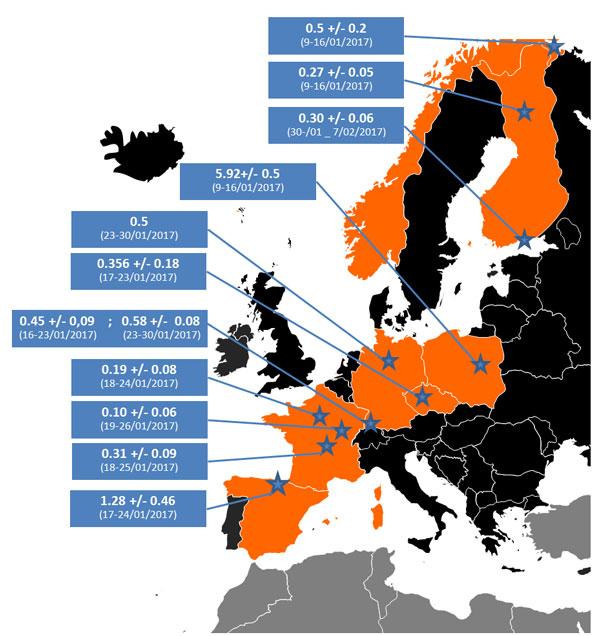Detection of radioactive iodine at trace levels in Europe in January 2017
Iodine-131 (131I), a radionuclide of anthropogenic origin, has recently been detected in tiny amounts in the ground-level atmosphere in Europe. The preliminary report states it was first found during week 2 of January 2017 in northern Norway. Iodine-131 was also detected in Finland, Poland, Czech Republic, Germany, France and Spain, until the end of January.
Iodine-131 is a radionuclide with a short half-life (T1/2 = 8.04 day). The detection of this radionuclide is proof of a rather recent release.
Besides the iodine release, the origin of which is still unknown, the poor dispersion conditions due to the thermal stratification [1] of the atmosphere also affected the observed concentration levels, including those of naturally occurring radionuclides such as Lead-210 (210Pb) [2], or fine particles (PM2.5 and PM10) leading to pollution episodes, particularly in the Western part of Europe during week 4 of January.
It must be pointed out that only particulate iodine was reported. When detectable, gaseous iodine is usually dominant and can be estimated to be 3 to 5 times higher than the fraction of particulate iodine.
In France, particulate 131I reached 0.31 µBq/m3 and thus the total (gaseous + particulate fractions) can be estimated at about 1.5 µBq/m3. These levels raise no health concerns.
The data has been shared between members of an informal European network called Ring of Five gathering organizations involved in the radiological surveillance of the atmosphere. In France, IRSN is responsible for monitoring the radioactivity of the atmosphere on a nation-wide scale. Its surveillance network OPERA-Air includes high-volume aerosol samplers (700 to 900 m3 of air per hour) and measurement equipment capable of detecting trace amounts of radioactivity.
Notes:
- Thermal stratification of the atmosphere that often affects the lower atmospheric layers in winter. The colder air at ground-level compare with altitude stuck or considerably limit atmospheric pollutant dispersion.
- The 210Pb concentration detected by IRSN peaked at 1600 µBq/m3 in January, four times higher than the usual mean value.
Particulate Iodine-131 (value +/- uncertainty) in the atmosphere(µBq/m3) :

